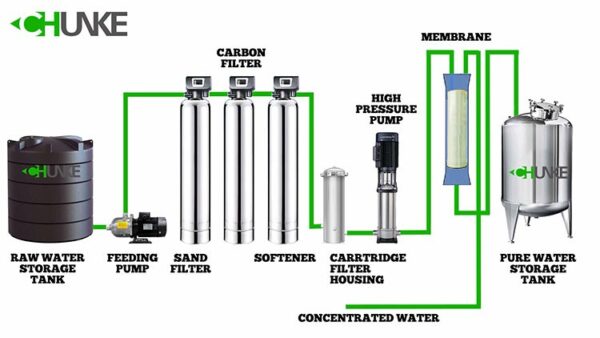Watch Video: You need to Know "How Does Reverse Osmosis Work?"
Here, we will explain “HOW DOES REVERSE OSMOSIS WORK?” with flow chart and video. First of all, we try to understand “What is reverse osmosis system?”
What is reverse osmosis?
Reverse Osmosis works by using a high pressure pump to increase the pressure on the salt side of the RO and force the water across the semi-permeable RO membrane, so, leaving almost all (around 95% to 99%) of dissolved salts behind in the reject stream.
What parts do reverse osmosis systems have?
First we see the parts of reverse osmosis system. raw water storage tank, feeding pump or booster pump, sand filter, carbon filter, water softener, Cartridge filter housing with pp filter, high pressure pump, membrane housing with ro membrane, waste water outlet, permeate clean water outlet, and clean water storage tank.
How does reverse osmosis system work?
First, From raw water tank, send water by feeding pump to sand filter to remove bigger particles and suspended solids, we are using quartz sand or some special filter media. Second, water goes to carbon filter to remove odor, taste, organic compounds and chlorine, we are using activated carbon or anthracite. Third water goes to water softener to remove hardness, there is ion exchange resin in softener tank, ion exchange resin exchange sodium with Ca, Mg which gives hardness to water.
After pretreatment, our water is ready to go reverse osmosis membrane, before reverse osmosis membrane to be sure there is no any particle in water, water goes to cartridge filter housing, generally we are using 2 or 5 micron pp cartridge filter.

Now, to remove all bacteria, viruses, vey small mineral, we send water to reverse osmosis membrane by high pressure pump, to remove all of them from water we need high pressure, because reverse osmosis membrane has vey very small pores, and we force water to pass this pores, and all other unwanted matter can not pass.
After our water passes reverse osmosis system, it is ready to drink or use in your process. As a result it is clean and safe. All dirty parts are send to drain or again treat.
Why we need RO system?
Clean and safe water is important for Drinking or using in your process. When you put water in a glass of cup, maybe you are thinking that it looks like clean, why i have to purify my water. And maybe your city management said that they are serving very clean water in World Health Organization norms.
But you can not be sure your pipes and storage tanks are clean and checked periodically or regularly. And guess,reparing the pipes, there is no any contamination to your water? Or if you use water in your industrial process, it is soft enough or no harmful matter inside for example nano – micro plastics, oils, gas, biocides, pesticides, herbicides, arsenic, reduce your end product quality.

To understand this one, our suggestion is to send your water to laboratory and get test result. And then you can be sure your water quality.
Reverse Osmosis or RO is a water treatment process that removes contaminants from water by using pressure to force water molecules through a semipermeable membrane. During this process, the contaminants are filtered out and flushed away, leaving clean, delicious drinking or process water. So, the treated water i mean clean water is called as permeate. The waste, dirty water left over is called the concentrate or brine. In reverse osmosis system, you can not purify all water. You should get some waste water, send to drain or treat again accordingly.
What is the minumum and maximum capacity for commercial and industrial reverse osmosis system?
Now, we see how system is working. Hence, Chunke is producer of commercial and industrial size reverse osmosis system, therefore, we are talking little big system, our smallest capacity is 100 liter per hour, biggest capacity for one set is about 7500m3 per day.
Why is reverse osmosis water so good?
Reverse osmosis water contains fewer contaminants, has lower sodium, has no parasites or bacteria, and is safer for cancer patients. So, It filters out pollutants through a membrane filter that doesn’t allow solids and prominent microbes to pass through.

What is not removed by reverse osmosis?
Reverse osmosis removed salt and mineral over 99%, just reverse osmosis cannot remove dissolved gases in water. As a result, all bacteria and viruses are removed. Maybe you think that, these minerals are important for health, is it good to remove all of them? If you want mineralized water, also we can add mineral dosing system to your reverse osmosis system, human get minerals not only from water, vegetables, fruits, rice, pasta, meats and our meals are full of minerals, and they are quite enough for our body.
Does reverse osmosis remove E coli?
Reverse Osmosis Systems have a very high effectiveness in removing bacteria (for example, Campylobacter, Salmonella, Shigella, E. coli); Reverse Osmosis Systems have a very high effectiveness in removing viruses (for example, Enteric, Hepatitis A, Norovirus, Rotavirus).
Does reverse osmosis remove toxins?
Reverse Osmosis water treatment is a great first step in residential home water treatment. And, for general municipal water supplies, RO can filter out the most concerning contaminants like lead, arsenic, and other heavy metals, as well as troublesome dissolved hard minerals.
How clean is reverse osmosis water?
The RO process can typically remove 90-99% of contaminants. Although not perfect, RO purification is a cost-effective method because if used properly RO membranes can last for years.

